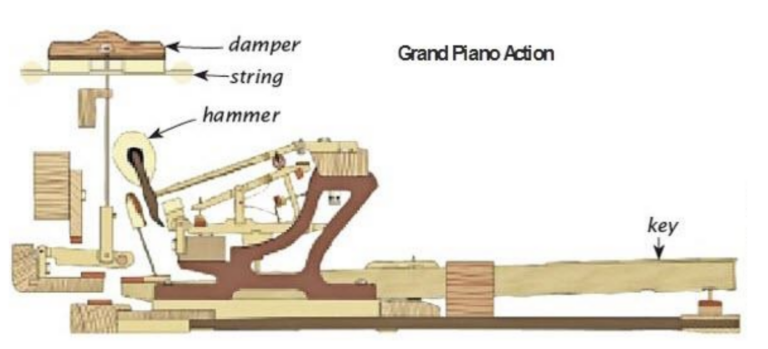WHAT IS REGULATION ANYWAYS?
Everyone understands that a piano needs to be tuned regularly for it to be pleasing to the ear when someone sits down to play it. But many don’t know that all pianos must be Regulated occasionally so that they will respond
correctly when being played.
So, what is Regulation, exactly?
Regulating involves adjusting all of the action parts so that they work together as designed, resulting in a “touch” that allows for good control when playing. This sounds pretty straight forward – 88 notes, so 88 adjustments, right? Well, it’s not quite that simple. In order to understand the process, let’s first consider the action itself.
There are somewhere between 2,000 and 6,000 parts in an average piano action. Although the number varies from one model to another (and how the parts are counted), suffice to say that there are a lot of parts. And these parts are mostly made from wood and felt, which as you can imagine change over time (wood shrinks and swells, felt compresses). So the factory regulation that your piano received when it was new slowly changes as it
ages and is played, requiring that adjustments be made to keep the piano set to “Factory Specs”.
If there are thousands of parts, then how many adjustments are we talking about here?
In fact there are 8 -10 adjustments per key that are made, totaling around 800. Some of these are set to a tolerance of .001 (a thousandth of an inch). Most pianos that we determine are “due for a regulation” are off by as much as ¼” (.250). The fact that these pianos even function is pretty amazing, but what is really amazing is how much of an improvement the client notices once the regulation is completed.
Another important fact is that the regulation is broken up into two areas; the Keys and the Action.
Key (or Keyboard) regulation consists of Leveling the keys so that they are all the same height when at rest, and then adjusting how far each key travels when pressed. There are instances where this portion of the regulation is within tolerance and can be skipped. The action portion of the regulation is another story. Since the majority of the adjustments are done there, coupled with the fact that the action takes most of the abuse when played, this is more often required.
How long does a regulation take?
An Action-only Regulation takes approximately 6 hours, sometimes more. Keyboard Regulation can add another 4-6 hours. Grand Actions generally require the action to be removed from the piano and taken to the shop, since all adjustments must be made on a special regulation bench. Upright actions (including old uprights, spinets, consoles, studios and professional uprights) are regulated in the piano, so the work is competed at the client’s home.


